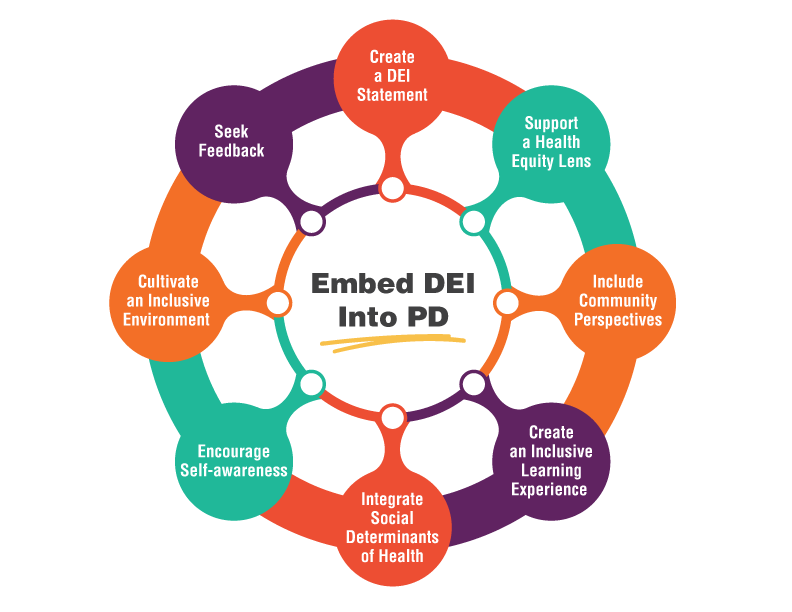Embedding diversity, equity, inclusion, justice, access, and belonging principles into professional development activities
The American Occupational Therapy Association’s (AOTA’s) Vision 2025 conveys a strong commitment to diversity, equity, inclusion, justice, access, and belonging (AOTA, 2019). This statement supports efforts to increase diversity, equity, inclusion, justice access, and belonging within all aspects of occupational therapy, including practice, education, and research. AOTA Approved Providers play a role in addressing health disparities by integrating diversity, equity, inclusion, justice, access, and belonging principles throughout educational content.

This document outlines recommendations that AOTA Approved Providers may embed into educational content and professional development (PD) activities but is not intended to be an all-inclusive guide. Recommendations and guidelines are offered below for consideration when planning, delivering, and evaluating PD content.
Organizational level
|
Recommendation |
How to do this |
|
|
Create a DEI statement. |
Create and publish an organizational DEIJAB statement that speaks to your organization’s commitment to diversity, equity, inclusion, justice, access, and belonging. |
External resources: |
|
Support a health equity lens. |
Increase instructors' capacity to discuss and address equity-related issues through awareness of their own identities, social position, bias, privilege, and power (Agic et al., 2022). |
|
Planning and development phase
|
Recommendation |
How to do this |
|
|
Include community perspectives. |
Gather and include the perspective of diverse groups during planning and developing. Incorporate a variety of embodied knowledge, experiences, and perspectives from the communities impacted to ensure educational content speaks to the person, community, systemic barriers, and occupational injustices (Alozie et al., 2021). |
|
|
Create an inclusive learning experience. |
Maintain focus on creating an inclusive learning experience. Ensure use of inclusive and respectful language, be aware of learner diversity, and eliminate stereotypes in educational content and materials. |
External resources: |
|
Integrate social determinants of health (SDOH). |
Acknowledge impacts of social determinants of health and discuss mitigating factors. Expand comprehension of specific population needs and the intersections with systemic oppressions. |
External resources: |
Delivery phase
|
Recommendation |
How to do this |
|
|
Encourage self-awareness. |
Incorporate teaching strategies that facilitate cultural self-awareness. Facilitate learner self-reflection on thoughts about themselves, their identities, biases, and broader societal context that influences their perspective during clinical decision-making. |
External resource: |
|
Cultivate an inclusive environment. |
Foster inclusivity through delivery of educational content. |
External resources: |
Evaluation phase
|
Recommendation |
How to do this |
|
|
Seek feedback. |
Implement a method for seeking feedback (e.g., post-evaluation) inquiring about how well the PD activity and instructors addressed DEIJAB. Add questions related to DEIJAB to post-evaluations. |
Address questions such as:
|
References
Agic, B., Fruitman, H., Maharaj, A., Taylor, J., Ashraf, A., Henderson, J., Ronda, N., McKenzie, K., Soklaridis, S., & Sockalingam, S. (2022). Advancing curriculum development and design in health profession education: A health equity and inclusion framework for education programs. Journal of Continuing Education in Health Professions, 00(00), 1-5. https://doi.org.10.1097/CEH.0000000000000453
Alozie, N., Lundh, P., Laguarda, K., Parker, C.E., Fujii, R., and McBride, B. (2021). Designing for diversity part 1: Where is equity and inclusion in curriculum design. Rockville, MD: National Comprehensive Center at Westat.
American Occupational Therapy Association. (2019). AOTA board expands Vision 2025. https://research.aota.org/ajot/article/73/3/7303420010p1/6575/AOTA-Board-Expands-Vision-2025
Noone, J. (2022). Preparing nurse educators to teach social determinants of health using backward design. Journal of Nursing Education, 61(9), 511-515. https://doi.org/10.3928/01484834-20220705-05